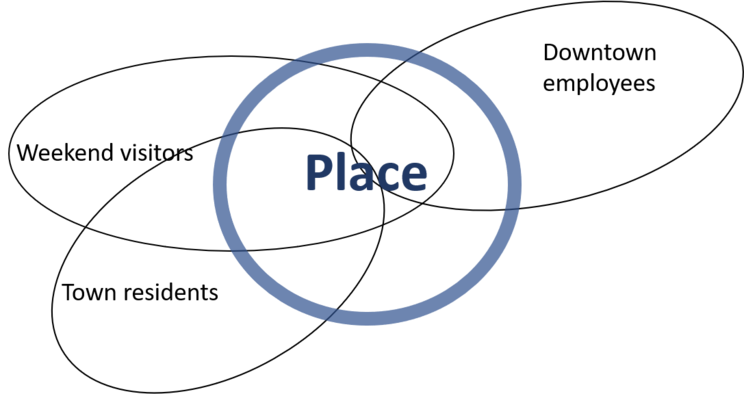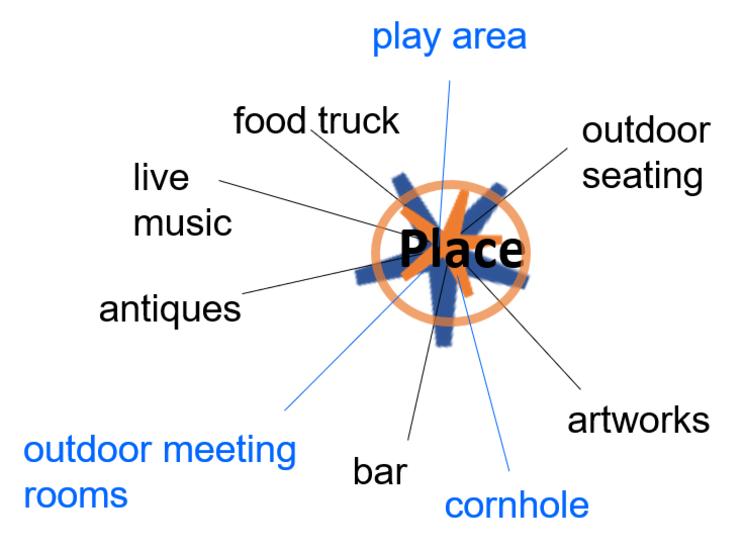About this blog series: This is Part 6 in a series that explores the notion that people are creatures like any other, and there are basic characteristics that we seek, or need, in our habitats. Part 1, Intro is here.
DIVERSITY
Good public spaces are the watering holes of our world, and everyone should want to be there. We make a huge mistake when we design for an “average user,” rather than thinking through as many potential audiences as possible. To quote from a Brookings Institution article, “If public spaces are designed and managed for a monolithic “public” or “average user,” they will likely be exclusionary and fail to achieve their goals of engendering social cohesion.”

One of the keys to creating vibrant places is to drill down on what potential audiences can be served with amenities and programming. Diversify your audiences and you will get immense payoff. Let’s say we plan to activate a vacant lot with a food truck, outdoor seating, some live music, and public art, and let’s throw in a weekend antique market and an outdoor bar. Pretty fun! There’s a space very much like this on the main street in Hudson, NY, where I spend a fair bit of my time.


But let’s admit that, busy as this place will probably be, we are not trying very hard to diversify our audience. We’re likely to leave out quite a few potential users. This space is great for attracting weekend visitors, town residents, and folks who work downtown.

An Example: Campus Placemaking
But that’s a pretty thin slice. What if we wanted to be more intentional and do our best to bring other audiences to our place, with higher goals in mind? Let’s imagine we’re in a college town and we’re trying to improve “Town-Gown” relations because there’s a certain amount of friction between residents and the college community (not an uncommon situation). So, our placemaking goal is to find a way to attract people from both communities – town, and gown – and promote integration and mutual respect. Well, we can do that and be very intentional about it.
The obvious place to start is by folding in the additional audiences we want to attract to our space, for example, college students, faculty, and staff. And let’s also throw in families with children to better round out the age groups. Let’s also consider all the remote workers who are looking for places where they can work outside on a nice day.

Now let’s go back to our programming exercise…what combination of activities and amenities would draw all these audiences and create that place where they could meet each other? Well, how about a play area to get the families…what about spaces that are designed especially for working outdoors on a laptop and can also accommodate small outdoor meetings. And let’s add cornhole (bean bag toss) as well – something everyone seems to love, but especially college students.

Fun, right? And it works. It can be a powerful way to achieve a community’s goals related to creating more integrated and diverse places. There are infinite ways to do it and endless combinations. Think of how to use this technique for more diversity along income and racial lines, or to help reduce political tribalism.
Building Social Capital with Public Spaces
Public spaces fulfill their potential when they are inclusive and welcoming to all, which is why I challenge my clients to go deeper in their thinking about their audiences and about using public engagement to bring out the best ideas that will attract those audiences.
Projects that meaningfully and effectively engage diverse voices lead to successful places and a strengthening of trust and social ties. Placemaking is effective in so many situations, but some of its most powerful expressions are when it answers a great social need, where bringing people together can accomplish great things. These are the places where our most important work is done.

